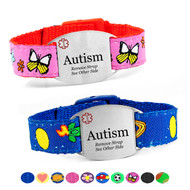What Do I Engrave on a Medical ID for Autism?
Posted by Lori Torman on 29th Oct 2025
For a medical ID for someone with autism, engraving should include their name, diagnosis, communication details, emergency contacts, and any co-occurring conditions or specific triggers. The most critical information should be highly visible, often on the front of a bracelet or necklace.
Essential information
- Name and date of birth: Use the name the person most commonly responds to. First responders can use this to build a connection and address them directly.
- Primary diagnosis: State "Autism," "Autism Spectrum Disorder (ASD)," or "Developmental Disability".
- Communication considerations:
- For individuals with limited or no verbal ability, include "NON-VERBAL" or "LIMITED VERBAL".
- For those with good receptive language but who may not speak in stressful situations, you could add "May not respond".
- Emergency contact ("ICE"): List one or two "In Case of Emergency" (ICE) contacts with their names and phone numbers. It is best to use a mobile number.
- Co-occurring conditions and medications: Include other critical medical conditions like Epilepsy, allergies, or diabetes. List any medications that first responders would need to know about.
Behavior and safety considerations
- Behavioral instructions: Provide cues to help first responders understand and manage potential behavior.
- Sensory sensitivity: Add "Sensory sensitive," or "Avoid loud noise/bright light".
- Emotional triggers: Indicate if the person may become agitated by physical touch or loud noises.
- Wandering/elopement: For individuals who tend to wander, or elope, you can engrave "Prone to wander" or "Drawn to water".
- De-escalation tactics: A small engraving, like "See ICE for calming cues," can prompt first responders to seek guidance from the emergency contact.
Example engravings
For a nonverbal child with sensory issues
- Front:
- Name: Sarah Jane Smith
- AUTISM, NON-VERBAL
- Back:
- ICE: Mom Jane (555) 123-4567
- ICE: Dad John (555) 987-6543
- Sensory sensitive. May resist touch.
For a teenager who is verbal but anxious in emergencies
- Front:
- Name: David Chen
- AUTISM, PANICS IN CROWDS
- Back:
- ICE: Mom (555) 555-1234
- See wallet for medical card. (This points to a more detailed card).
Important considerations
- Consult a doctor: Always discuss engraving specifics with a doctor or specialist to ensure all relevant health information is included.
- Add a medical card: Consider using a medical ID that directs people to a more detailed wallet card, as there is limited space for engraving. This card can hold information about communication preferences, sensory needs, and triggers.
- Consider product type: Medical IDs come in many styles, including bracelets, necklaces, and shoe tags, so you can select one that the person is most comfortable wearing.
StickyJ Medical ID offers custom engraved medical ID bracelets for children and adults with Autism.
This is for informational purposes only. For medical advice or diagnosis, consult a medical professional.


